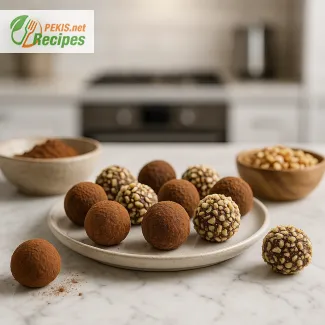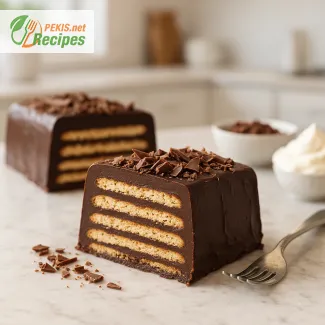
Traditional German Rouladen: A Flavorful Beef Dish You’ll Fall in Love With
Discover the rich heritage of Germany’s beloved beef roulades
When it comes to hearty, comforting meals that carry the warmth of tradition and the depth of slow-cooked flavor, few dishes can rival the classic German Rouladen. This beloved recipe has long graced family tables across Germany, especially on Sundays and during festive gatherings. With its origins deeply rooted in Central European culinary heritage, Rouladen is more than just a recipe—it's a cultural icon that brings together thinly sliced beef, tangy mustard, crisp pickles, smoky bacon, and onions, all rolled into savory bundles of joy.
The name Rouladen stems from the French word rouler, meaning "to roll," a nod to the elegant technique of rolling beef around a flavorful filling. Over time, this method traveled and evolved through generations, becoming a staple of German home cooking. Today, it continues to be cherished not just for its nostalgic value, but also for its irresistible flavor and satisfying richness.
Every bite of this slow-braised delicacy tells a story of culinary craftsmanship—where simple ingredients are elevated through methodical preparation and time-honored techniques. Whether served with buttery mashed potatoes, pillowy potato dumplings (Kartoffelklöße), or red cabbage on the side, Rouladen makes for a truly heartwarming main course that’s perfect for autumn evenings, winter celebrations, or whenever you crave something soul-satisfying.
What sets German Beef Rouladen apart is the contrast in textures and flavors: the tenderness of the beef after hours of braising, the burst of acidity from the pickles, the savory depth of bacon, and the sweet sharpness of sautéed onions all come together in perfect harmony. Once seared to perfection and slowly simmered in a rich brown gravy, these meat rolls transform into fork-tender parcels that practically melt in your mouth.
For many, Rouladen is synonymous with family gatherings and holiday traditions. Passed down from Oma to Enkel, this dish carries the kind of love that can’t be rushed—only cooked low and slow, with care and attention. Whether you’re introducing it to your own table for the first time or revisiting a childhood favorite, preparing Rouladen is a delightful experience that bridges the old with the new.
This dish has also found its way into kitchens far beyond Germany’s borders, appealing to lovers of European comfort food worldwide. From cozy countryside inns in Bavaria to bustling metropolitan kitchens in Berlin, Rouladen remains a favorite, even finding its place on modern dinner tables in North America and beyond, where foodies are increasingly drawn to authentic, slow-cooked meals with character and soul.
Making German beef roulades at home might seem like a special occasion project, but with a bit of preparation and the right technique, it can easily become one of your go-to comfort meals. The ingredients are humble—affordable cuts of beef, pantry staples like mustard and onions, a couple of pickles, and bacon—but the result is remarkably rich and deeply satisfying.
In this guide, we’ll walk you through everything you need to know to prepare this time-honored German favorite, including expert tips for getting the beef perfectly tender, creating a robust gravy, and assembling your roulades for even cooking. Whether you’re a curious cook exploring international dishes or a nostalgic soul yearning for flavors from home, this authentic German recipe will earn a permanent spot in your culinary repertoire.
Let the savoriness of Rouladen welcome you into the world of traditional German cuisine—where rustic ingredients meet thoughtful preparation, and every roll is packed with flavor, history, and love.
- Tenderize the beef: Lay the beef slices flat and use a meat mallet to pound them to about 5 mm thickness. Ensure each slice is even for easier rolling.
- Season and fill: Spread each beef slice with yellow mustard, then season with salt and pepper. Place a few strips of bacon, a spoonful of chopped onion, and chopped pickles on one end of each slice.
- Roll and secure: Tightly roll each beef slice, starting from the end with the filling. Secure each roulade with kitchen twine or toothpicks to prevent unrolling during cooking.
- Sear the roulades: Heat the vegetable oil in a large heavy-bottomed pot over medium-high heat. Sear each roulade on all sides until browned, then remove and set aside.
- Prepare the sauce base: In the same pot, add remaining chopped onions and sauté until golden. Stir in tomato paste and cook for 1–2 minutes. Deglaze with red wine if using, scraping up browned bits from the bottom of the pot.
- Simmer: Return the roulades to the pot. Add beef broth and bay leaves. Bring to a simmer, cover, and cook on low heat for about 90 minutes, until the beef is tender.
- Make the gravy: Remove roulades and set aside, covered. Mix flour and water into a slurry, then whisk into the cooking liquid. Simmer until thickened into a rich gravy.
- Finish and serve: Remove toothpicks or twine from the roulades. Return them to the gravy to heat through before serving.
Creative Ways to Elevate Your Classic Beef Rouladen at Home
Small changes that make a big difference in flavor and texture
While the traditional German beef rouladen is already a masterpiece of Central European comfort food, there is always room for thoughtful innovation. Whether you want to enhance the flavor, make the dish more wholesome, or simply avoid common mistakes that could affect the final result, there are many ways to improve upon the original recipe without losing its essence. Cooking at home allows for full control over ingredients and technique, which means you can personalize this dish to suit your preferences, dietary needs, or elevate it to restaurant-level quality.
Choosing the right cut of beef for tenderness and flavor
Although many traditional recipes call for topside or flank steak, the choice of meat can drastically change the outcome. If you’re aiming for extra tenderness, consider using sirloin tip or even shoulder cuts with good marbling. These cuts may require a slightly longer cooking time but reward you with melt-in-your-mouth roulades. Additionally, pounding the beef evenly is crucial. Uneven slices will cook inconsistently, leading to either overcooked or chewy sections. Always ensure your meat is uniformly thin—ideally around 5 mm—to roll easily and cook evenly.
Enhancing the filling with gourmet additions
The standard filling of bacon, mustard, onions, and pickles offers an exceptional balance of savory, tangy, and smoky notes, but there are plenty of ways to customize and refine this combination:
- Caramelized onions instead of raw chopped ones will add a sweet depth to balance the acidity of pickles.
- A sliver of smoked cheese like gouda or gruyère inside each roulade can introduce a creamy, indulgent layer that melts into the filling.
- For a hint of herbal freshness, finely chopped fresh thyme or parsley can be added to the filling.
- A touch of horseradish or grainy mustard instead of yellow mustard can intensify the sharpness and give it a rustic flair.
These small tweaks allow the rouladen to maintain its traditional roots while offering a modern and personalized twist.
Improving the gravy for deeper richness
The sauce that accompanies rouladen is often underrated, but it plays a vital role in unifying the dish. Here are a few ways to take your gravy to the next level:
- Deglazing with red wine not only adds complexity but also lifts the caramelized flavors from the pan.
- Adding a spoonful of mushroom powder or sautéed mushrooms during the cooking process imparts umami richness.
- A splash of balsamic vinegar or Worcestershire sauce can balance the richness with gentle acidity.
- If you prefer a thicker, silkier gravy, use unsalted butter whisked with flour (a roux) instead of plain flour slurry.
Taking time to develop a well-balanced sauce ensures your roulades are coated in a flavorful, glossy gravy that elevates every bite.
Why homemade rouladen beats store-bought or restaurant versions
Cooking rouladen at home offers several advantages. First, you control the quality of ingredients, from the freshness of the beef to the amount of salt or fat used. Store-bought versions may rely on preservatives or shortcuts that compromise flavor and texture. Moreover, homemade rouladen can be adapted to your own dietary needs—whether that’s lowering the sodium content, avoiding allergens, or switching to grass-fed beef for a richer nutrient profile.
Home cooking also allows for flexibility in side dishes. While red cabbage and dumplings are traditional, you might prefer roasted root vegetables, buttery mashed potatoes, or even a simple green salad for a lighter touch.
Avoiding common mistakes that ruin rouladen
Even experienced cooks can fall into traps that affect the final result. Some of the most common pitfalls include:
- Overstuffing the roulades, which causes them to fall apart or cook unevenly.
- Inadequate browning before braising, which diminishes the flavor complexity.
- Boiling instead of simmering, which can toughen the beef and create a greasy sauce.
- Skipping the resting period before slicing, which allows the juices to redistribute and ensures moist, tender meat.
By paying attention to technique and not rushing the process, you’ll achieve rouladen that’s both visually appealing and deeply flavorful.
Healthier adaptations for a lighter version
For those who love rouladen but are looking for a healthier twist, here are some practical ideas:
- Use turkey or chicken breast slices instead of beef for a leaner protein.
- Replace bacon with smoked tofu strips or lean turkey bacon for reduced saturated fat.
- Swap traditional flour with gluten-free alternatives like rice flour or arrowroot powder.
- Opt for low-sodium broth to keep sodium levels in check.
- Instead of using butter in the gravy, finish with a drizzle of extra virgin olive oil for healthier fats.
These modifications help maintain the soul of the dish while adapting it to modern dietary goals.
Making rouladen a part of your personal culinary tradition
Once you master the core elements of rouladen, you can begin to experiment and make it your own. Perhaps you want to try regional variations, like adding mushrooms as done in southern Germany, or using smoked paprika for a Hungarian-inspired flavor. You could even create a vegetarian roulade using thinly sliced eggplant or cabbage leaves as the wrapper.
Whatever path you take, the beauty of rouladen lies in its ability to honor tradition while inviting innovation. Whether you stick to the classics or explore new interpretations, the care and intention behind each step will always shine through.
Contains mustard and gluten (from flour).
To make it gluten-free, replace all-purpose flour with cornstarch (same amount) or a certified gluten-free flour. For mustard allergy, omit mustard and use a mustard-free marinade such as olive oil with herbs and vinegar.
- Vitamin B12: 2.6 µg (100% DV) – essential for red blood cell formation and brain health
- Iron: 3.2 mg (18% DV) – supports oxygen transport and energy production
- Zinc: 6.5 mg (60% DV) – aids immune function and wound healing
- Vitamin B6: 0.7 mg (50% DV) – important for protein metabolism
- Selenium: 32 µg (58% DV) – protects cells from oxidative stress
- Lycopene (from tomato paste): 1.2 mg – may support heart health and protect against certain cancers
- Quercetin (from onions): 9 mg – has anti-inflammatory and immune-modulating effects
- Polyphenols (from red wine, if used): up to 100 mg – beneficial for cardiovascular health





